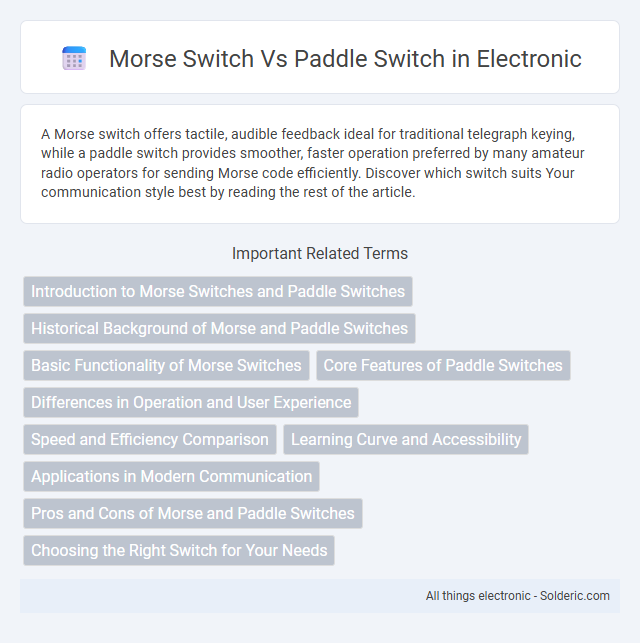A Morse switch offers tactile, audible feedback ideal for traditional telegraph keying, while a paddle switch provides smoother, faster operation preferred by many amateur radio operators for sending Morse code efficiently. Discover which switch suits Your communication style best by reading the rest of the article.
Comparison Table
| Feature | Morse Switch | Paddle Switch |
|---|---|---|
| Design | Small lever operated by finger | Flat paddle or lever operated by hand |
| Primary Use | Morse code transmission in telegraphy | Amateur radio Morse code keying (speed paddling) |
| Operation | Single key press for dot and dash manually timed | Dual lever allowing electronic generation of dots and dashes |
| Speed | Limited by operator's manual timing | Enables higher sending speed with electronic keyers |
| Complexity | Simple mechanical switch | More complex; requires electronic keyer |
| Typical Users | Traditional telegraph operators, beginners | Experienced amateur radio operators |
Introduction to Morse Switches and Paddle Switches
Morse switches and paddle switches serve as primary manual keying devices in amateur radio communications, each designed for efficient Morse code transmission. Morse switches typically feature a single lever with two contact points, enabling straightforward dot and dash input, while paddle switches use dual levers to produce dots and dashes through side-to-side manipulation. Both devices optimize operator speed and accuracy but differ in ergonomics and input technique, influencing user preference in Morse code sending.
Historical Background of Morse and Paddle Switches
Morse switches, rooted in the 19th century telegraphy era, were designed for transmitting Morse code through simple, robust mechanical contacts, becoming a cornerstone in early communication technology. Paddle switches emerged later as a refined counterpart, offering more ergonomic and faster keying suitable for amateur radio operators seeking improved speed and comfort. Understanding the historical background of these switches highlights their distinct evolution and critical roles in the development of manual telegraphy and modern radio communication.
Basic Functionality of Morse Switches
Morse switches operate by rapidly opening and closing an electrical circuit to generate short and long signals, representing the dots and dashes of Morse code for communication. These switches are designed to be simple and reliable, allowing efficient manual transmission of coded messages through on-off keying. Their basic functionality centers on precise timing and tactile feedback, enabling accurate signaling over telegraph lines or radio frequencies.
Core Features of Paddle Switches
Paddle switches feature a wide, flat actuator designed for easy, precise thumb control, enhancing user comfort and responsiveness. Unlike Morse switches that rely on simple on-off toggling, paddle switches enable smoother, more nuanced inputs ideal for CW operators seeking speed and accuracy. Your communication experience benefits from the ergonomic design and tactile feedback that paddle switches uniquely provide.
Differences in Operation and User Experience
Morse switches operate by sending short and long electrical pulses mimicking traditional Morse code, requiring precise timing and rhythm, while paddle switches utilize dual-lever designs for smoother, quicker manipulation and higher speed sending. Your experience with Morse switches will involve more deliberate finger movements and greater focus on timing accuracy, whereas paddle switches allow for faster, more fluid keying with less physical effort. The choice impacts your comfort, efficiency, and learning curve during Morse code transmission.
Speed and Efficiency Comparison
Morse switches offer precise control with tactile feedback, allowing skilled operators to achieve high sending speeds, typically up to 30-40 words per minute, making them efficient for rapid manual keying. Paddle switches, designed for electronic keyers, enable even faster speeds--often exceeding 60 words per minute--by automating dot and dash timing, which reduces operator fatigue and increases overall efficiency. Choosing the right switch for your operation depends on your preferred speed and comfort level during extended CW (continuous wave) transmissions.
Learning Curve and Accessibility
Morse switches typically have a steeper learning curve due to their precise timing requirements and need for manual rhythm control, making them less accessible for beginners. Paddle switches offer a more intuitive design, allowing users to produce dots and dashes with separate levers, which simplifies learning and improves accessibility. For new operators, paddle switches reduce the initial complexity, accelerating skill acquisition in Morse code communication.
Applications in Modern Communication
Morse switches and paddle switches both serve critical roles in modern amateur radio communications, enabling efficient manual keying of Morse code signals. Morse switches, often used in traditional telegraphy and basic keying setups, provide straightforward on/off control, while paddle switches allow operators to send dots and dashes rapidly through dual-lever mechanisms, enhancing speed and precision in CW (continuous wave) transmissions. The paddle switch's ergonomic design and compatibility with electronic keyers make it the preferred choice for high-speed, real-time Morse code communication in current amateur radio contexts.
Pros and Cons of Morse and Paddle Switches
Morse switches offer simple and reliable operation with tactile feedback, making them ideal for beginners, but they can cause finger fatigue during prolonged use. Paddle switches enable faster sending speeds with dual-lever designs that reduce hand strain, though they require more practice to master and are typically more expensive. Your choice depends on whether ease of use or speed and efficiency is your priority.
Choosing the Right Switch for Your Needs
Selecting the right switch between Morse and paddle options depends on your communication style and operational preferences. Morse switches offer a traditional, straightforward design ideal for precise, rhythmic tapping, while paddle switches provide smoother, faster keying through dual-lever action, enhancing efficiency in high-speed transmissions. Consider your comfort with manual dexterity and transmission speed to find the perfect match for your amateur radio setup.
Morse switch vs paddle switch Infographic

 solderic.com
solderic.com